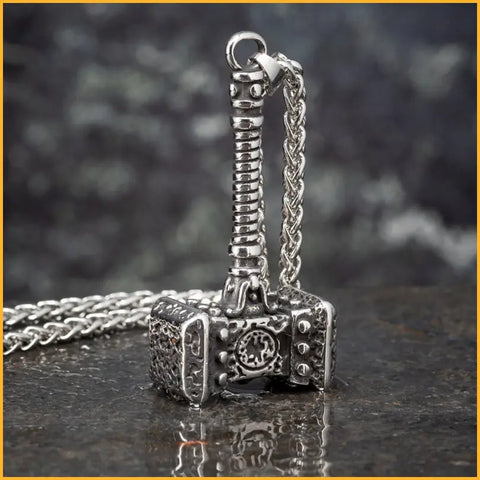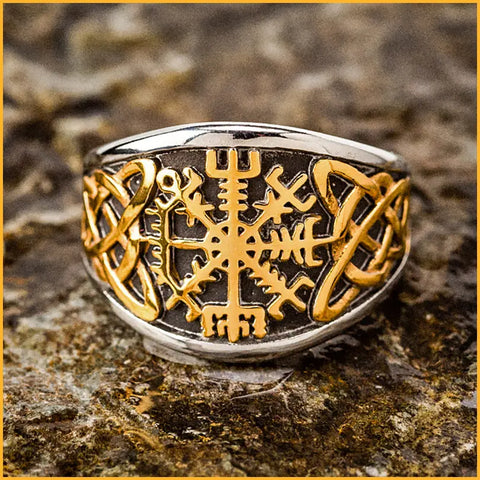Your Cart is Empty
Menu
-
- Shop by Type
- End of Line Sale Items
- New In
- Viking Gifts Under $30
- Hand Forged Axes
- Silver Viking Jewelry
- Stainless Steel Jewelry
- Cremation Jewelry
- Necklaces and Pendants
- Hand Carved Wooden Pendants
- Kings Chains
- Viking Drinking Horns
- Pendant Chains
- Rings
- Bracelets
- Earrings
- Beard Beads and Beard Rings
- Collectables
- Ceramic Mugs
- Street Wear
- Horn Jewelry
- Bronze and Pewter Jewelry
- Shop by Theme
- Viking Axe
- Celtic Jewelry
- Dragon or Serpent
- Viking Raven
- Wolf / Fenrir
- Rune Jewelry
- Odin Jewelry
- Ram / Goat
- Shieldmaidens / Lagertha
- Sword, Spear or Arrow
- Thor's Hammer / Mjolnir
- Tree of Life / Yggdrasil
- Helm of Awe / Aegishjalmur
- Triquetra or Triskelion
- Valknut / Knot of Slain
- Vegvisir / Viking Compass
- Veles / Bear
- Blogs
- Help
-
- Login

Viking Myths, Legends and Symbols : A Brief Summary

Here at Norse Spirit, we are on an endless quest to find the best jewlery designs that reflect all aspects of Norse and Viking culture.
Many of our customers are well versed in the history and meaning of many of their legends, symbols and designs, but many are also just starting to explore the wonder of the Norse / Viking culture.
In this post, we explore some of the more common symbols used in the Viking age and hope it will spur you on to continue your investigations into the fascinating history and culture of the Vikings.
(click on the images to view the product in store)
Mjölnir (Thor's Hammer)
Possibly the most common and popular symbol of all is the mighty Mjolnir or Thor’s Hammer. The recent batch of ‘Marvel’ movies has also helped boost its popularity among those who previously had little, or no knowledge of Vikings.
Thor is often referred to as the God of Thunder (his name is derived from ancient language roots meaning ‘thunder’), and it is widely believed that the sound of thunder is actually Thor crashing his ‘Mjolnir’ onto the skulls of his enemies.
The Mjolnir is probably one of the most famous weapons in Norse mythology and is certainly considered to be the most effective, and feared, weapon used in the defense of Asgard, the stronghold of the Norse Gods. Apart from its immense power, its effectiveness was certainly increased by the fact that no matter how often it was used, it always returned to the hand of Thor, like a boomerang, ready to be used again and again!
The story is not all of violence and war however as it is said that the Mjolnir was also used during ceremonies to bless births and marriages (and probably during funerals too).
When something, or someone, was blessed using the Mjolnir they were considered to be protected from evil spirits and so many people now wear the Mjolnir as a symbol of protection as well as strength.
See our range of Mjolnir inspired designs HERE
Yggdrasil
Yggdrasil, commonly referred to as the ‘Tree of Life’, is probably one of the most widely known symbols in Norse and also Celtic culture, and certainly one of the most regularly used in jewelry designs.
Yggdrasil is a mighty tree, (allegedly an Ash tree but not surprisingly there is no firm evidence of this) that is said to live in the center of the Norse cosmos. The roots of the tree grow deep into mythological wells and springs, and the towering branches of the tree connect the ‘Nine Worlds’ of Norse mythology which is why it is often referred to as the ‘Tree of Life’.
The name itself comes from two separate words in old Norse: ‘Yggr’, meaning ‘terrible’ (a reference to the powerful reputation of the God Odin); and ‘drasill’ meaning horse, so the literal translation is Horse of Odin. This may seem a bit odd for something referred to as the ‘Tree of Life’ but one of the many legends of the tree is that as part of his quest to learn the meaning of the Runes (which the mysterious maidens of fate carved into the trunk of the tree), the God Odin hanged himself from the tree to demonstrate his worthiness to gain their secrets. The image of his limp and lifeless body hanging from a large branch of the tree has been described in Norse poetry as being like a ‘horse and rider’ – hence the references to Horse of Odin.
Yggdrasil is considered so fundamental to the wellbeing of the Cosmos that it is said that if the tree starts to tremble, this will be the signal that the time of ‘Ragnarok’ has come – the destruction of the universe!
See our range of Yggdrasil inspired designs HERE
The Helm of Awe
The Helm of Awe (or Helm of Terror) is commonly used in Viking / Norse mythology as a symbol of protection. It is also known by its old Norse name of Aegishjalmur – pronounced ‘EYE-gish-owlmer’
There is a quote in the famous Poetic Edda which is often referred to as the source of the reference to the Helm of Awe being a symbol of protection
“The Helm of Awe
I wore before the sons of men
In defense of my treasure;
Amongst all, I alone was strong,
I thought to myself,
For I found no power a match for my own”
It is often said that Viking warriors used to draw the Helm of Awe on their foreheads to instil fear in their enemies. The design seems to depict protective spears emanating from a central core and therefore protecting from all angles of attack.
Today, it is one of the most popular designs for those wanting Viking inspired tattoos, and of course, it is also widely used in jewelry designs too.
See our range of Helm of Awe inspired designs HERE
Vegvisir
The Vegvisir is generally believed to provide guidance or to lead lost souls back onto safe ground, which is why it is often referred to as the ‘Viking Compass’. The translation from modern Icelandic of ‘that which shows the way’ also helps feed this theory.
The Vegvisir is one of the most controversial of the ‘Viking’ symbols, as there is absolutely no evidence that it existed in Viking times. There is only one known reference to it in an Icelandic document known as the ‘Huld manuscript’ and this dates from the 19th century, so although it is very widely used in all things Viking or Norse, you will also find many enthusiasts who will tell you that it has absolutely NOTHING to do with the Vikings.
The Vegvisir is often confused with the Helm of Awe as they are both eight point symbols. Our hint on how to tell them apart is this: the Vegvisir is known as the compass and all its ‘points’ are different, just as the points on a compass are. In the Helm of Awe, all the points are the same as they are spears fighting a common enemy.
See our range of Vegvisir inspired designs HERE
Valknut
The Valknut (pronounced VAL-knoot) is one of the most easily recognised symbols featuring three inter-locking triangles.
Although the symbol has been found on Viking age runestones in Sweden, its name is actually derived from modern Norwegian and is loosely translated as ’knot of those fallen in battle’. In that most famous of mythological places, Valhalla, the God Odin is said to be there to welcome warriors who have fallen in battle.
As for its meaning no-one really knows for sure, but historians have tried hard to understand its meaning from the various different places they have seen it appear.
Based on archaeological evidence, it is clear that the Valknut is associated with death having been seen on runestones, burial sites and cremation urns. It is very common for there also to be a representation of Odin alongside the Valknut which is perhaps not surprising given the association with Valhalla already mentioned, and that he is considered to be the God who will guide the spirits of the dead into the underworld, and possibly back to the living world again.
Among Odin’s many powers, it is said that he has the power to ‘bind and unbind’; references in historical poems say that he could ‘lay bonds on the mind’ which would make men weak in battle, but he could also ‘loosen the tensions of fear and strain’. It is often thought that there is a connection between these ‘binds’ and the representation of the interlocking triangles.
Other theories around the Valknut make references to ‘Hrungnir’s Heart’ mentioned in the famous 13th century ‘Prose Edda” which states that his heart was ‘made of hard stone with three sharp-pointed corners’
The fact that the symbol is made up of three triangles, giving it nine corners or points, often brings comparison with the ‘Nine Worlds’ of Norse Mythology.
So, who knows the true story, but based on historical and archaeological evidence, the links with Odin and death in battle certainly seem the most plausible.
See our range of Valknut inspired designs HERE
We will do our best to revisit some of these symbols again in future posts and go into them in a bit more detail.


